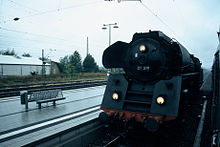Planned steam

Planned steam means the covering of regular trains with steam locomotives , often in connection with contemporary rolling stock. The idea came up in the late 1980s. Initially, those responsible only had to bear the additional costs for using the steam locomotive. The background was that there were still many operational steam locomotives in the area of the former GDR, the infrastructure was still available in many places (e.g. turntables , water cranes , coaling systems , sanding systems ) and the mostly low maximum speed allowed the use of steam locomotives.
Planned steam events are becoming increasingly rare, as the infrastructure necessary for steam operation is lost in the course of route modernization . At the beginning of the 1990s, the plan steam was still relatively common in East Germany. On the other hand, after the modernization, the speed will be increased and the timetable will be designed accordingly, so that steam locomotives can no longer meet the speed requirements, but also secondary conditions such as the automatic closing of the doors.
Passenger trains are mostly used for organized scheduled steam events. Freight train events are rarer and last only once a year on the Eisenach – Bad Salzungen – Meiningen section of the Werra Railway .
In southern Germany, the BEM has established itself as a plan steam organizer since 2016 . Due to the stock of sufficient large locomotives ( BR 01 , BR 44 , BR 50 , S 3/6 and BR 52 ), own route and customers with corresponding freight volume in freight traffic, it is relatively easy to plan steam events around the Ries with additional photo or passenger trains align.